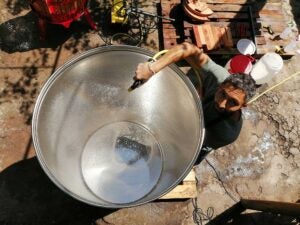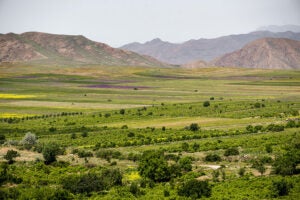The small Asian nation of Armenia, part of one of the world’s oldest wine regions, traces viticulture back 11,000 years to the South Caucasus Mountains and is where the common grape vine (vitis vinifera) found its roots. Combined with neighboring Georgia, Turkey, and Iran, this area shaped the vine we savor today.
In the Soviet era, Armenia’s winemaking took a pivotal role within the communist power’s expansive winemaking system. Key players like the Yerevan Brandy Co., operating under state ownership, played vital roles in the economy, navigating production goals mandated by the state.
During this period most of Armenia’s grapes were destined for brandy. It’s estimated that a quarter of the Soviet Union’s brandy production came from Armenia.
Yet during that span, making more wine took precedence over trying to make quality wine.
Today, Armenia emphasizes the importance of its winemaking legacy, characterized by the cultivation of indigenous grape varieties such as Areni and Voskehat. These varieties thrive in high elevations and volcanic soils and contribute a unique and unparalleled flavor profile.
While Armenia’s vintner legacy stands as a testament to centuries-old traditions, it has seamlessly adapted to the challenges and opportunities of the modern era.
Current-day wine and grape industry in Armenia
In 1991, with the decline of the U.S.S.R. and the shift of farmland from state and collective operations to private ownership, the Armenian wine industry underwent significant growth. Notable wineries, such as WineWorks, emerged as global champions, showcasing how individual dedication and innovation could transform the entire landscape.
Modern winemakers — such as Aimee Keushguerian and Kevork George — are at the forefront, helping shape the future of Armenian winemaking.
Keushguerian owns Zulal Wines and works for her family’s sparkling winery, Keush. As an award-winner winemaker, Keushguerian remains grounded in her roots, cultivating grape varietals native to her country.
“Areni and Voskehat play a huge role in shaping our wine industry,” she said. “Areni, a beautiful noble grape, holds tremendous promise with its thick skin, tight clusters, and the ability to develop concentrated flavors and aromas. It thrives in our climate and soil, truly reflecting specific sites. Similarly, Voskehat is a robust white grape variety with incredible versatility. In Vayots Dzor, the same valley, you can harvest it for sparkling wine, still wine, and late in the season for a delightful dessert wine.”

The wines Keushguerian is making highlight the versatility of the native grape varietals.
Keushguerian is among the most prominent winemakers in Armenia who are championing the native grape varietals and showing the world that great wines can be produced in her country. She holds a crucial role in the Armenian winemaking industry, so much so that both she and her father were prominently featured the streaming series SOMM. The series began a decade ago, showcasing four sommeliers as they attempted to pass the notoriously difficult master somm examination.
Building upon the foundation of indigenous grapes, Armenia’s winemaking scene has evolved to embrace a rich diversity of styles, from traditional classics to innovative trends.
Kevork George is an up-and-coming winemaker based in the Vayots Dzor Province of south central Armenia. His brand, Arakil Wines, is known for its distinctive low-intervention winemaking style. This brings a dynamic twist to the ever-evolving landscape of Armenian winemaking, with George placing a special emphasis on creating organic and biodynamic-style wines.
“The Armenian market is following the demand of the wine trends,” he said. “For example, a few years ago, you could only find classic conventional wines. But nowadays, you can find Armenian: low alcohol, sparkling wines (PetNat), Rose, natural wines (organic and biodynamic), and orange wines.”

Armenia’s diverse regions and sustainable viticulture practices showcase a dedication to quality and preservation of the land and traditions that’s been producing amazing wines for thousands of years. The distinctive flavors, shaped by diverse climates, volcanic and limestone soils, and high-altitude vineyards, capture the essence of Armenia’s current and past winemaking tradition.
Geopolitical issues plague Armenian farming
The journey of Armenian winemaking is not without its challenges, however. One significant issue is the ongoing geopolitical tensions in the region, particularly with neighboring Azerbaijan, where unresolved regional conflicts have affected trade routes, transportation, and overall economic conditions.
Additionally, Armenia’s geopolitical position and historical ties have made it susceptible to external pressures from larger regional players.
“We sit in between Turkey and Azerbaijan, who are constantly causing conflict and threatening our territorial integrity,” Keushguerian said. “So, it is very challenging, and extremely high risk. A lot of our vineyards sit on the borders here.”
Some of the vineyards and wineries are so close to the border that the Armenia lost five crucial wineries in 2020. The country has also lost a significant amount of its oak forests, which were its main source of barrel production in the country.
“Stock of good quality Armenian barrels are running low (Since Artsakh was a source for good quality wood for barriques), and European ones are very expensive,” George said. “Some winemakers hope that the northern region of Tavush might eventually replace Artsakh as a source for wood and barrels.”

Farming is difficult on its own, but when you factor in the risks of war, the stakes go beyond harvesting this year’s crop. It becomes a matter of navigating violence and other dangers while tending to the vines.
The 2020 Harvest for Keushguerian and her family with Keush was during the 2020 Artsakh war. During this time Keushguerian was unsure if they would be able to harvest the 2020 vintage due to the conflict in the region. The decision was made that they would harvest despite being in the linesight of an opposing army base.
“Our vineyards for Keush were planted 120 years ago, before the Soviet Union, and were planted before the two military bases were built,” she said. “So, they sit in between the two military bases, and they act like our border. We are in direct firing range standing in the vineyards.”
Keushguerian added, ”Most of the grape farmers have war and military training. During the 2020 war, harvest almost didn’t happen. There are times that we have military escorts and approval to visit the vineyards. On a day-to-day basis, I am in the vineyards quite a bit, but it requires a lot of coordination and thought.”
When looking at the contributions of Armenians, the journey becomes a microcosm of the broader narrative. It’s a story of passion, resilience, courage, and innovation where tradition meets the challenges of a changing world. It’s a testament to the profound connection between the land, its people, and the stories told through every bottle.
David Salazar serves as the 2024 American Farmland Trust Agriculture Communications Intern at AGDAILY, with a focus on helping to amplify diversity and minority voices in agriculture. David is originally from King City, California, and attended the University of California, Fresno, as a first-generation college student. He received a bachelor’s degree in viticulture and enology and has worked in California’s premier wine producing regions.




